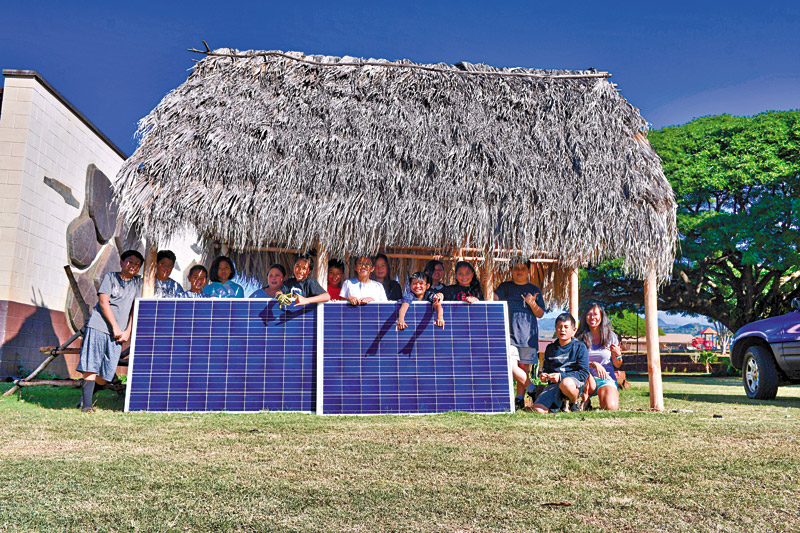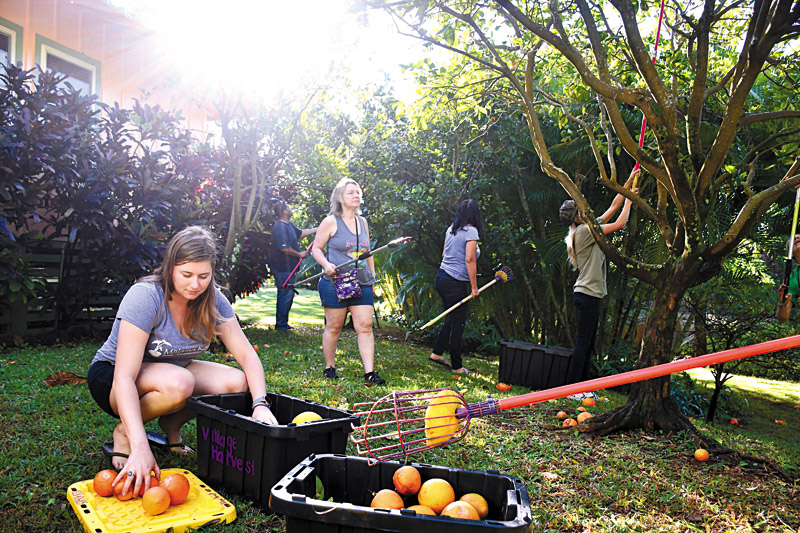Eye On The ‘Ä€ina
With a focus on native land, community and culture, MÄlama Kaua‘i is hoping to take the island’s food sustainability setup to a whole new level.
The popularity of creating sustainable communities has exploded in recent years. In 2016, Hawai‘i hosted the IUCN World Conservation Congress, the first-ever in the U.S.
It was then, at the opening ceremony three years ago, that Gov. David Ige set forth target points for his Sustainable Hawai‘i Initiative.
However, a decade earlier, before the term “sustainable community” became common vernacular, there was Mālama Kaua‘i. The founders were pioneers, in a sense, hard at work quietly planting the seeds that would one day create a foundation steeped in environmental sustenance.
Founded in 2006, the organization is a community-based nonprofit focused on advocating, educating and driving action toward a sustainable island home.
But what exactly does it mean to create a sustainable community?
“It’s hard to sum up what a sustainable Kaua‘i really encompasses, in short, but essentially we are trying to support a community-led economy that protects our ecosystems and natural resources, creates green jobs, and emphasizes indigenous values and vision,” says Megan Fox, executive director of Mālama Kaua‘i.
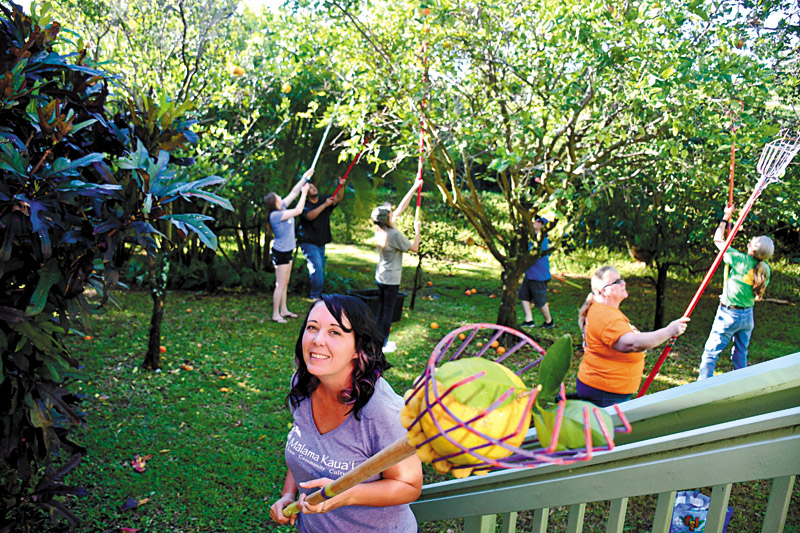
MÄlama Kaua‘i Executive director Megan Fox works to gather extra fruit from a KÅloa residence for MÄlama Kaua‘i’s Village Harvest program.
In the last few years, the organization has focused on increasing local food consumption and production, building community capacity, and growing interest in sustainable tourism. It already has a substantial list of programs to that end, including the 8-acre Kalihiwai Community Farm, Kaua‘i Ag Internship Program, Village Harvest and the Mahi‘ai Technical Assistance Program.
Next month, it will launch its newest project, an island-wide Farm-to-School hui. The program’s project manager, Lorilani Keohokalole, is a Hawaiian practitioner and community advocate with more than 20 years of experience in Hawaiian education.
She says the program will focus on developing a network of “like-minded and like-hearted” stakeholders who want to strengthen Kaua‘i’s farm-to-school framework.
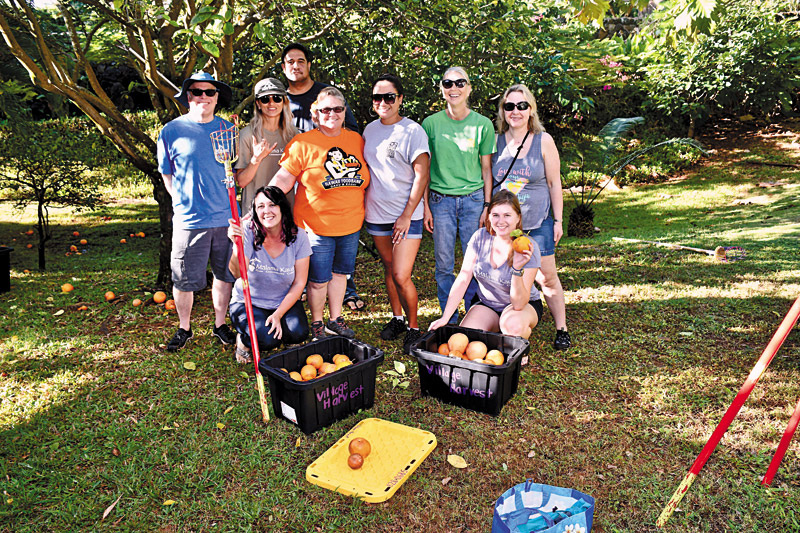
Mālama Kaua‘i partners with organizations like Hawai‘i Foodbank’s local chapter for community service projects, including its Village Harvest program, which rallies volunteers to salvage extra fruits and veggies to donate to those in need.
“So many schools and organizations have been working on these efforts for years, if not decades, and we’re excited to see the potential of what could (be) when everyone works together with some unified visions,” Keohokalole says.
The Farm-to-School program will service DOE and charter schools in communities that have high Supplemental Nutrition Assistance Program-Education qualifications.
“We are looking at the potential of establishing projects that increase policy, systems and environmental changes to facilitate increased food access among SNAP-eligible populations on island,” Keohokalole continues.
Students who are part of programs like this are able to dive into educational aspects of agriculture. According to Keohokalole, they learn about different types of vegetable and fruit varieties, as well as how to grow them. They also get hands-on experience with caring for gardens, orchards and lo‘i, and how to harvest, prepare and consume food in sustainable ways.
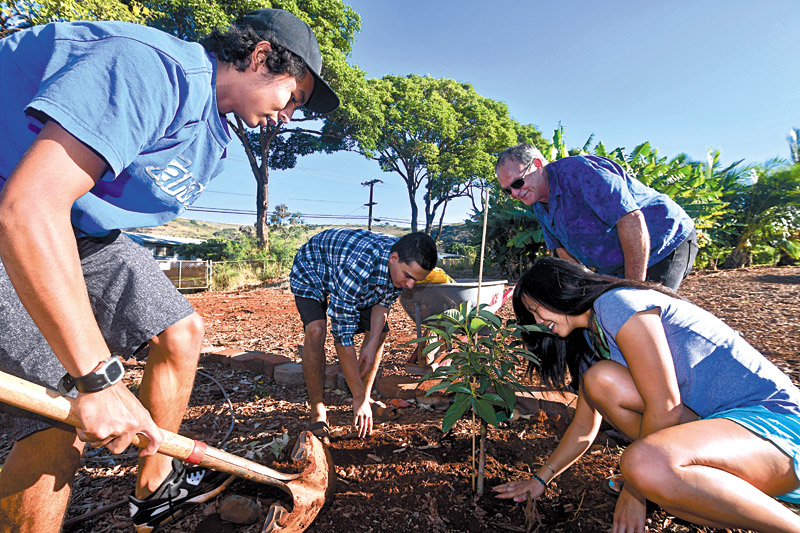
With guidance from Mālama Kaua‘i, Waimea High School teens plant trees on campus and continue to grow its budding agricultural program.
As Mālama Kaua‘i works to create a better future with an eye toward sustainability, it is simultaneously laying the groundwork for a new generation that will carry on the effort. The organization actively engages the island’s keiki with programs like Kaua‘i School Garden Network, Māla‘ai Kula farm-to-school pilots and the Giving Tree grant.
“The Giving Tree program is a new project that helps us to connect with nonprofits and schools wanting to host their own mini-orchard … as a way to build the sustainability of the Village Harvest program,” Fox explains. “We consider the interrelatedness of all issues and the need for a holistic approach, with a focus on three primary areas: ‘āina, community and culture.”
Through Village Harvest, residents, farmers and others donate produce — often fruit falling from underutilized trees — and community volunteers distribute unused produce to schools, after-school programs, food banks and other nonprofits, with the help of partners such as Hawai‘i Food Bank’s Kaua‘i branch. Since 2015, Village Harvest has distributed over 84,000 pounds of fruits and vegetables, according to Fox.
“There is so much abundance on Kaua‘i that we could easily double that if we had enough volunteers,” Fox adds.
The organization depends heavily not only on volunteers but also on the AmeriCorps VISTA program, which has helped by providing full-time service members for the past three years.
“2019 is our last year hosting the members, so we’re especially focused on programmatic sustainability and strategizing, so that we can try to transition those roles into quality jobs for community members,” Fox continues.
As Mālama Kaua‘i plans for a sustainable future, it continues to honor the community, its past, and the traditions and skills that have been passed down through generations.
“We acknowledge all of those that have come before us, to lay down the foundations of this work in all the ways that we can now pick it
up and carry it forward,” Keohokalole says. “We also acknowledge the families of all the students here on Kaua‘i. Many have skills in hunting, lawai‘a (fishing), coastal gathering, making salt, keeping bees and work that we are not, in this moment, able to circle in … but we are holding them as equally important. This work is kuleana. It shouldn’t be easy. However, with many hands, the work can be light.”
For more information, visit malamakauai.org.


